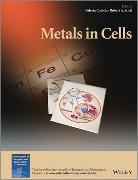- Start
- Metals in Cells
Metals in Cells
Angebote / Angebote:
Editors
Valeria Culotta, Johns Hopkins University, Baltimore, MD, USA
Robert A. Scott, University of Georgia, Athens, GA, USA
The last half-century has seen an explosive growth in our understanding of the role of inorganic elements in biology, focusing first on biochemical function of proteins with tightly bound metals. As a result, many structures and functions of biomolecules with metals have been characterized. In parallel, the understanding of inorganic elements in medicinal chemistry and the development of metal-containing drugs has developed.
This research led inevitably to an interest in how Nature incorporates inorganic elements into metalloproteins and how cells "manage" their "inorganic portfolio, " acquiring the right amount of each element in the right location without making mistakes, while avoiding toxicity. More recent research efforts have focused on this understanding of inorganic cell biology. Significant advances have been prompted by a combination of new methods to probe intracellular metal locations and the dynamics of metal movement in cells, high-resolution detection of metal-biomolecule interactions, and the revolution of genomic, proteomic, metabolic, and even "metallomic" approaches to the study of inorganic physiology. Environmental metals and metalloids, including iron, copper, zinc, cobalt, manganese, molybdenum, and selenium, are all accumulated by cells and organisms in the micro- to millimolar range. Yet despite this abundant sea of diverse metals, only the correct metal cofactor is matched with a partner metalloprotein - mistakes in metal ion biology rarely occur. At the same time, free metal ions can be detrimental to cellular components and processes, so systems have evolved to carefully control trace element concentrations and locations (homeostasis).
This book covers recent advances made by top researchers in the field of metals in cells [the "metallome"] and includes: regulated metal ion uptake and trafficking, sensing of metals within cells and across tissues, and identification of the vast cellular factors designed to orchestrate assembly of metal cofactor sites while minimizing toxic side reactions of metals. In addition, it features aspects of metals in disease, including the role of metals in neurodegeneration, liver disease, and
inflammation, as a way to highlight the detrimental effects of mishandling of metal trafficking and response to "foreign" metals. This book is an important addition to the bioinorganic literature and relates new discoveries in systems biology and toxicology to new results in bioinorganic chemistry.
About EIBC Books
The Encyclopedia of Inorganic and Bioinorganic Chemistry (EIBC) was created as an online reference in 2012 by merging the Encyclopedia of Inorganic Chemistry and the Handbook of Metalloproteins. The resulting combination proves to be the defining reference work in the field of inorganic and bioinorganic chemistry, and a lot of chemistry libraries around the world have access to the online version. Many readers, however, prefer to have more concise thematic volumes in print, targeted to their specific area of interest. This feedback from EIBC readers has encouraged the Editors to plan a series of EIBC Books [formerly called EIC Books], focusing on topics of current interest. EIBC Books will appear on a regular basis, will be edited by the EIBC Editors and specialist Guest Editors, and will feature articles from leading scholars in their fields. EIBC Books aim to provide both the starting research student and the confirmed research worker with a critical distillation of the leading concepts in inorganic and bioinorganic chemistry, and provide a structured entry into the fields covered.
Lieferbar in ca. 10-20 Arbeitstagen
